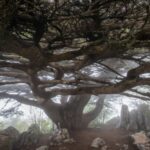By Jessica Haller
Revised July 2021
There is one place in the world today where you can still touch the grandchildren or perhaps even the sibling trees of the actual trees King Solomon ordered to build the First Temple. The Cedars of Lebanon still stand in Barouk forest, Shouf Biosphere Reserve South of Beirut – a UNESCO World Heritage site. The last 17 square miles remain of the Cedars of Lebanon. They are ancient, tall, wide, amazing specimens. Scientists report that the stand will be extinct by the end of this century. In 2021 political and economic upheaval in the country further jeopardizes the reserve.
Cutting those trees was Solomon’s first command when he began instruction to build the Temple. King Solomon knew the trees – as the wisest man in the world, the text of the book in Kings 1 says he “discoursed” on the trees – and knew their powers. Cedars of Lebanon live for thousands of years. Their wood does not rot, it resists fire, smells wonderful, conducts sound in wonderful ways, and is extremely strong. The Phoenicians used the Cedars of Lebanon to build their ships, and the Egyptians used it for paper. Solomon knew the Cedars of Lebanon would stand forever and chose their wood as the floor and walls of the Temple. Walking through the halls of the Temple you would have touched the Cedars.
We have been mourning the destruction of the first temple for 2,600 years, while the forests in Lebanon have continued to grow and stand tall. Until now. The Cedars of Lebanon, Cedrus Libani are expected to be near extinct by then of this century.
On the 9th of Av, July 18, 2018 the front page of the NYT carried a story Climate Change is Killing the Cedars of Lebanon.
I do not know what coincidence or divine intervention moved the editors to publish that story on that day – about the eventual extinction of the Cedars of Lebanon – the walls and planks of the Beit Hamikdash, the Temple, whose destruction we were mourning on the 9th of Av, but I took note.
The article describes the trees; they thrive in the high elevation and cool temperatures of the Barouk Forest.
Moisture from the Mediterranean provides cloud cover.
Snowy winters at the high elevation are important for the trees and seeds which require a freeze to engender germination.
The cool nights have protected the trees from disease and bugs which are often kept in check by freezing nights.
But 7% of the forest has succumbed to disease since 1997 as the warmer nights keep the insects alive and warm inside the trees.
Rainy days have decreased from 105 average per season to 40. Warmer surface temperatures are increasing temperatures up the mountains, forcing the cool air upwards. At some point, trees run out of elevation to climb. The trees have nowhere to go.
Humans have tried to protect these trees before. In 1876 Queen Victoria tried to protect a 102 hectare grove by financing a high stone wall. Local goats were eating saplings and endangering the future of the grove.
And since 1998 Cedars of God forest has been a UNESCO world heritage site, our more modern form of protection. No walls will protect the less than 17 square miles that remain.
Rabbi Dina Najman taught that Tisha B’av is, and the destruction of the Beit HaMikdash was, a failure to self-critique. The sinat hinam or baseless hatred that is spoken about as the cause of the destruction is another way of saying the people were unable to look inwards and make themselves better. On the outside they seemed to be serving G!d, but inside, they were not serving each other.
In our world today 25% of humanity is living under water-stress, global mass migration has begun because the Earth is no longer producing as it has for millennia. People cannot feed their children; the earth is scorched from 365 day-long wildfire season; 500,000 million people suffer annually from drought. There are images from the book of Eicha that ring true around the world today – mothers that cannot feed their children; the tongue of a suckling cleaving to the roof of its mouth for lack of nourishment; children asking for bread where there is none. And I maintain it is in part due to a failure at self-critique.
And there is a uniquely Jewish perspective in this Cedars story. These trees were selected because they are nearly immortal. Yes, the Phoenicians built their ships with these trees and the Egyptians used them to make paper. But the Phoenicians and the Egyptians are not here – Jews and the Trees still are. For now.
This Tisha B’av, while reading Eicha, think about the baseless hatred that comes with understanding that it is humanity’s footprint on our Earth and our failure to fight baseless hatred that brought us here: to a moment when we can still touch the same trees that built our temple 3,000 years ago – and can see on the horizon a moment when we will no longer be able to.
Jessica Haller is Vice Chair of the Hazon Board.
